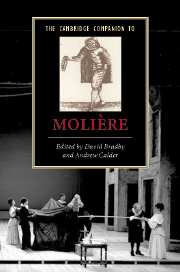Book contents
- Frontmatter
- 1 The career strategy of an actor turned playwright: 'de l’audace, encore de l’audace, toujours de l’audace’
- 2 The material conditions of Molière’s stage
- 3 The master and the mirror: Scaramouche and Molière
- 4 Molière as satirist
- 5 How (and why) not to take Molière too seriously
- 6 L’Avare or Harpagon’s masterclass in comedy
- 7 Laughter and irony in Le Misanthrope
- 8 Comédies-ballets
- 9 Le Bourgeois gentilhomme: Molière and music
- 10 Medicine and entertainment in Le Malade imaginaire
- 11 Molière and the teaching of Frenchness: Les Femmes savantes as a case study
- 12 L'École des femmes: matrimony and the laws of chance
- 13 Molière nationalised: Tartuffe on the British stage from the Restoration to the present day
- 14 Landmark twentieth-century productions of Molière: a transatlantic perspective on Molière: mise en scène and its historiography
- 15 Dom Juan the Directors’ Play
- 16 ‘Reculer pour mieux sauter’: modern experimental theatre’s debt to Molière
- Select bibliography
- Index
- Series List
12 - L'École des femmes: matrimony and the laws of chance
Published online by Cambridge University Press: 28 March 2007
- Frontmatter
- 1 The career strategy of an actor turned playwright: 'de l’audace, encore de l’audace, toujours de l’audace’
- 2 The material conditions of Molière’s stage
- 3 The master and the mirror: Scaramouche and Molière
- 4 Molière as satirist
- 5 How (and why) not to take Molière too seriously
- 6 L’Avare or Harpagon’s masterclass in comedy
- 7 Laughter and irony in Le Misanthrope
- 8 Comédies-ballets
- 9 Le Bourgeois gentilhomme: Molière and music
- 10 Medicine and entertainment in Le Malade imaginaire
- 11 Molière and the teaching of Frenchness: Les Femmes savantes as a case study
- 12 L'École des femmes: matrimony and the laws of chance
- 13 Molière nationalised: Tartuffe on the British stage from the Restoration to the present day
- 14 Landmark twentieth-century productions of Molière: a transatlantic perspective on Molière: mise en scène and its historiography
- 15 Dom Juan the Directors’ Play
- 16 ‘Reculer pour mieux sauter’: modern experimental theatre’s debt to Molière
- Select bibliography
- Index
- Series List
Summary
Mon Dieu, ne gagez pas, vous perdriez vraiment.
L’École des femmes, II, 5, 474[Good Lord, don’t bet! You’re bound to lose!]
When Molière married the actress Armande Béjart in 1662, he was forty years old and exactly twice her age. It remains unclear to this day whether Armande was the daughter or the younger sister of Madeleine Béart, Molière's former mistress and co-founder of the Illustre Théâtre, but she was born in 1642, during the same year that Madeleine and Jean-Baptiste became lovers. Some speculation arose as to whether the actor had married his own daughter and his rival Montfleury went as far as to present a written accusation of incest to Louis XIV. Although the scandalous rumours eventually subsided, Molière's marriage to a much younger woman was fraught with predictable infidelities and strife. In examining L'École des femmes (1662) with regard to the circumstances surrounding its creation, its reception and its literary value, it is impossible to avoid some speculation regarding the conflation of life and text. For one thing, Molière's marriage to Armande was conspicuously staged in early 1662, framed by the June 1661 production of L'École des maris and the December 1662 production of L'École des femmes.
Of equal significance to our understanding of the play is the polemical quarrel that followed the tremendous success of Molière's first major opus. L'École des femmes was the author's eighth play and his first five-act comedy in verse. The play marked a turning point in Molière's career, away from traditional farce and toward a new type of comedy that dared to bridge the gap between the comedic and tragic genres.
- Type
- Chapter
- Information
- The Cambridge Companion to Moliere , pp. 165 - 176Publisher: Cambridge University PressPrint publication year: 2006



